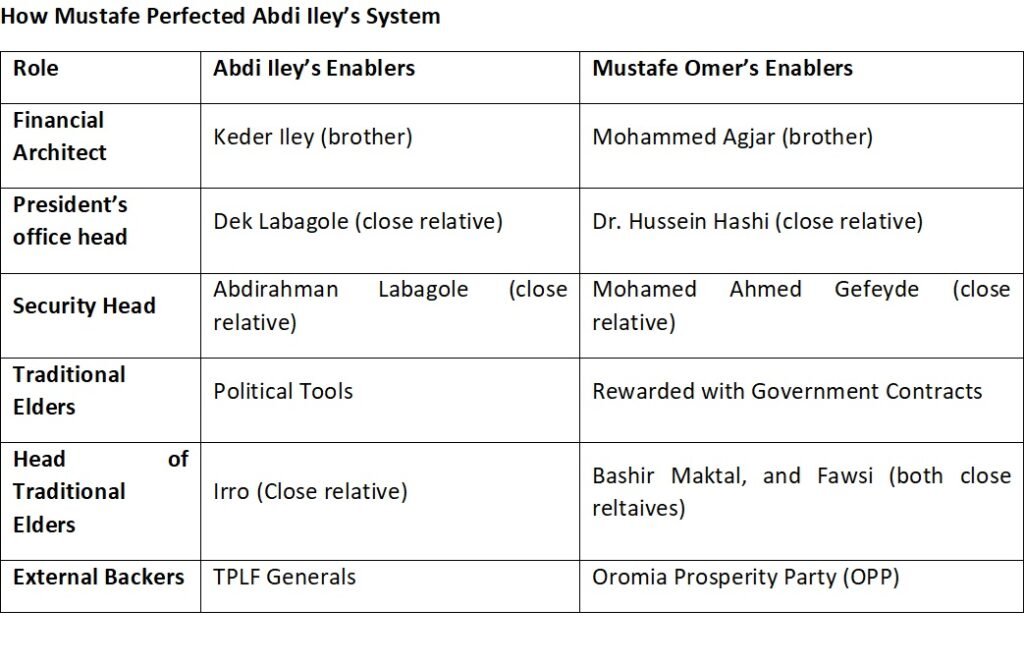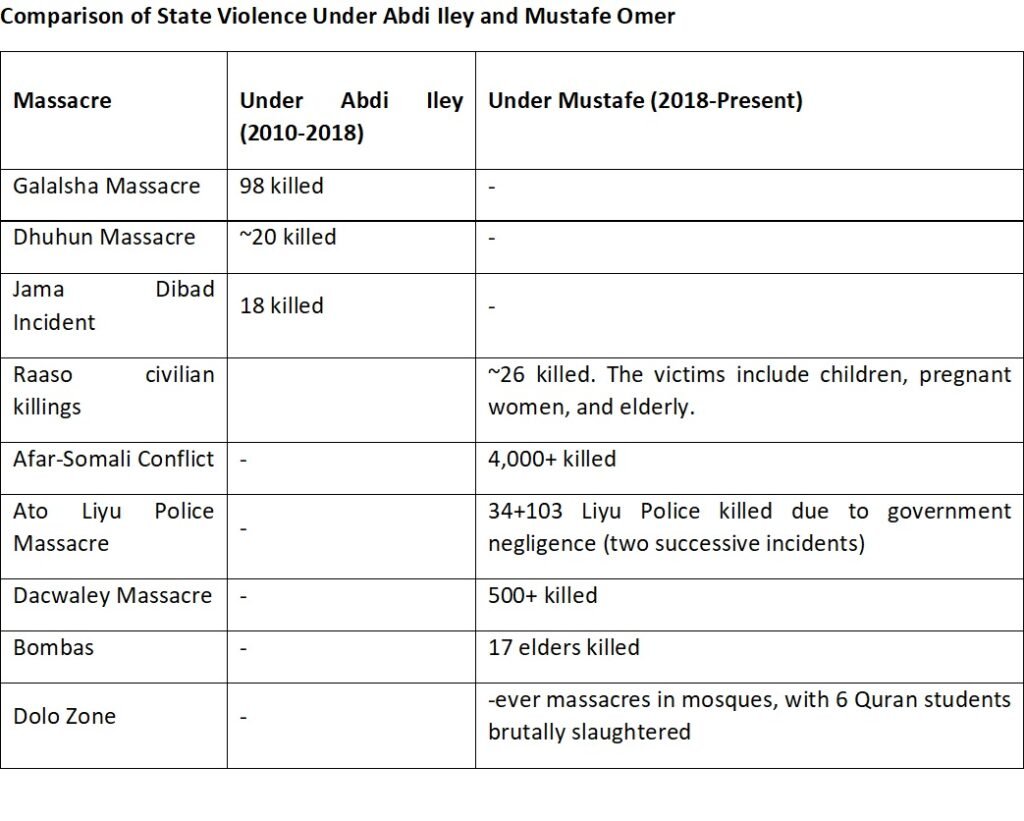By Abdulfatah Hussein
The article Ethiopia’s Cash Cow: The Kenni Cabal Draining the Somali Region exposed how an entrenched OPDO elite, known as the Kenni Cabal, has siphoned resources from the Somali region for the last six years. But before them, the TPLF-led EPRDF ruled the region in much the same way, draining its wealth under a different banner. The faces have changed, but the system remains the same—a system built on external exploitation, sustained by internal collaborators.
As someone who has worked within the government, I have witnessed firsthand how power is wielded not for the people but for a select elite, where governance is reduced to a means of personal enrichment. The Kenni Cabal is not an occupying force in the traditional sense—it rules through Somali hands, using Mustafe Omer and his allies as enforcers to maintain its grip on the region’s wealth. The greatest betrayal is not just external exploitation but the complicity of those who should have defended the Somali people.
As the Somali proverb warns, “O tree, if a part of me were not a part of you, you would not be able to cut me.” The Somali people are not just being plundered by outsiders—they are being sold out by their own leaders. While Ethiopia’s Cash Cow rightfully highlights the economic extractions imposed by the Kenni Cabal, it does not fully expose Mustafe Omer’s role as their chief collaborator—a leader who has not only sold out his own people but perfected the art of internal betrayal. His rule has co-opted traditional elders, suppressed dissent, and transformed governance into a carefully managed illusion, one designed to protect the interests of external elites while giving Somalis nothing but repression and false promises.
This article is not written by an outsider. It comes from within—from someone who has seen the system up close and knows that the rot runs deeper than most realize. The Kenni Cabal may now control the region’s wealth, but it is simply the latest face of a long-standing system of looting. Whether it was the TPLF before or the OPDO-backed Kenni Cabal today, the result is the same: a captured economy, a colony in all but name.
But what happens when a population pushed to its limits finally pushes back? The Somali region is not just suffering—it is on the verge of a reckoning that will define its future.
The Myth of Mustafe’s Reform
The article correctly identifies how successive Ethiopian regimes have viewed the Somali region as a financial reservoir rather than a political constituency. Under the TPLF-controlled EPRDF, the region was governed through military repression, while under the current administration, economic exploitation has taken a more sophisticated form. While it attributes the Somali region’s continued suffering to this federal policy, it fails to hold Mustafe Omer accountable for his role in propping up this exploitative system.
The closure of Jail Ogaden, the signing of the ONLF peace deal, and the withdrawal of federal troops were not achievements of Mustafe’s leadership. These decisions were made in Addis Ababa before he was installed as president. Mustafe did not lead a political transition—he walked into a region where reforms were already underway and repackaged them as his success story. This gave him the political cover needed to entrench his rule, allowing him to impose an administration that is as repressive and corrupt as that of his predecessor, Abdi Iley.
A direct comparison between the two regimes reveals stark similarities rather than fundamental differences:

Traditional Elders: From Custodians to Political Pawns
Historically, Somali elders were guardians of justice, mediating conflicts and upholding community trust. Under Mustafe’s rule, however, their role has been corrupted, creating a divide between genuine elders who serve their people and those embedded within the regime for personal gain.
Among the most prominent co-opted elders is Garad Kulimiye, who has taken control of government offices, including the Jigjiga Water Service and Public Works Office, turning them into private revenue centers. Civil servants must rent office spaces, while contracts are awarded with little oversight. Ugas Mustafe is another key figure, using his position to secure state resources and silence dissent.
Mustafe weaponizes elders to suppress opposition. In 2022, when protests erupted over corruption, he ordered elders to publicly condemn demonstrators, legitimizing further crackdowns. Rather than representing the people, they now serve as enforcers of repression.
As the Somali proverb warns, “Af wax cunay xisho”—“A mouth that has eaten stays silent.” These elders have traded their integrity for power, ensuring that resistance never gains ground before it is crushed.
Corruption Institutionalized
One area where Ethiopia’s Cash Cow does not go far enough is in illustrating the extent to which corruption has been entrenched under Mustafe’s administration. Unlike Abdi Iley, who centralized theft within his close relatives, Mustafe has democratized corruption, allowing every bureaucrat, traditional elder, and civil servants a share of the spoils in exchange for their silence.
While millions of Somalis face severe food insecurity, with humanitarian agencies warning of widespread starvation, Mustafe’s inner circle enjoys a life of unchecked extravagance. Instead of addressing the food crisis gripping the region, the president’s closest aides live in luxury, dining on meals prepared by personal chefs flown in from Egypt. This stark contrast between the ruling elite’s indulgence and the suffering of ordinary Somalis exemplifies the complete disconnect between Mustafe’s administration and the realities on the ground. In a region where people struggle for basic survival, the leadership’s blatant display of excess is not just corrupt—it is an insult to the very people they claim to govern.
The education sector, infrastructure, and public services all suffer from systemic corruption. A third of allocated funds are immediately stolen, leaving contractors without enough money to complete the work. Many simply abandon the project or misappropriate the remaining funds, waiting for the next budget cycle to repeat the process. Schools operate without basic resources. Medical centers lack medicine and equipment. Water shortages persist despite multi-million-dollar budget allocations.
While the article rightfully blames external actors for some of these failures, it ignores Mustafe’s direct role in institutionalizing this system of theft. His administration is not just corrupt—it has perfected corruption as a governing principle.
Mustafe’s Silent War on Civilians
The closure of Jail Ogaden ended highly visible atrocities under Abdi Iley, but state violence did not stop. Instead, it became more decentralized and insidious, with secret detention houses, political kidnappings, and extrajudicial killings now defining Mustafe Omer’s rule.
Numerous testimonies indicate that opposition figures have been abducted, detained in undisclosed locations in Jigjiga, and only released after families paid ransoms. Others vanish without a trace, with security forces operating with total impunity. Some, like Dr. Nimcaan Hamare, died shortly after release, raising concerns about torture and mistreatment.
While Abdi Iley’s brutality was overt and state-directed, Mustafe has overseen a more widespread and chaotic escalation of violence.
- More people have been killed under Mustafe than during Abdi Iley’s rule.
- Massacres in mosques and Quran students’ killings, once unimaginable, have now happened.
- Ethnic conflicts and inter-clan wars rage unchecked, with record-high casualties.
Beyond large-scale massacres, Mustafe’s forces have conducted targeted killings in Jigjiga and Aw Bare, while interethnic violence in Moyale and Gura Dhamole has devastated communities. Yet, he maintains a carefully crafted reformist image, masking his deadly legacy behind propaganda.
The numbers do not lie: the so-called reformer has become more lethal than the tyrant he replaced.

Silencing Dissent
Despite branding himself as a reformist, Mustafe Omer has built a regime of repression, silencing dissent through detention, exile, and intimidation. Even officials beyond his reach, like Abdi Jemal, the former regional justice bureau head, were kidnapped from Addis Ababa for refusing to submit.
While shutting down independent media, Mustafe personally oversees multiple Facebook pages, using them as propaganda tools to fuel clan divisions and manufacture public discourse. Rather than informing or governing, he redirects public outrage toward rival clans, shielding himself from accountability while deepening social fractures.
In 2022, Mustafe shut down all independent press presence in Jigjiga, including the BBC Somali office, ensuring that no credible media could operate within the region. His strategy is clear: eliminate the free press, control information, and incite division. Unlike Abdi Iley, who at least bribed journalists, Mustafe erases them altogether. His rule is not reform but a ruthless consolidation of power, ensuring no opposition can challenge his grip on the region.
Mustafe Omer: The Kenni Cabal’s Loyal Collaborator
The Kenni Cabal does not rule the Somali region directly—it rules through Mustafe Omer, who serves as their enforcer and political shield. Ronald Robinson’s theory of collaboration explains how dominant powers rarely govern through brute force alone; instead, they rely on local intermediaries to suppress dissent and facilitate resource extraction. Just as colonial regimes used native rulers to tax, police, and administer local populations on their behalf, the Kenni Cabal uses Mustafe to legitimize their plunder while avoiding direct responsibility.
This model explains why external exploitation has intensified rather than diminished under Mustafe’s rule. He provides the illusion of local governance, allowing the Kenni elite to extract wealth while keeping their hands clean. When public resentment grows, it is Mustafe—not the true economic elites—who bears the brunt of popular anger. His role is not that of a ruler but a buffer, ensuring that external interests remain unchallenged.
But history is clear: collaborators always fall before their masters do. The Kenni Cabal, insulated from local accountability, will continue operating even if Mustafe is removed. But Mustafe, having built his rule on enforcing external interests, will find no allies when his usefulness expires. The forces that sustain him today will be the first to abandon him when the political climate shifts. He is not an autonomous ruler; he rents power, and like all tenants, he will one day be evicted.
The Somali Region at a Breaking Point
The Somali region stands at a crossroads. Mustafe Omer’s collaboration with the Kenni Cabal has deepened economic plunder, suppressed dissent, and eroded any pretense of governance. His rule is not a deviation from past oppression but a more refined model of exploitation—one where local betrayal shields external interests from accountability.
But history is unforgiving to collaborators. The same forces that empower Mustafe today will discard him when his utility fades. The Kenni Cabal, protected by its distance from public resentment, will remain intact unless the entire system of internal complicity is dismantled.
The Somali region is no longer merely suffering—it is on the brink of an irreversible crisis. Years of corruption, repression, and economic decay have left the population disillusioned and restless. If genuine reform does not come from within, instability will be imposed from without. The question is no longer whether Mustafe’s rule will collapse—but whether it will take the entire region down with it.
Abdulfatah Hussein
Emai: abdulfatah.hussein78@gmail.com
———-
Related articles:
Beyond the Official Narrative: Unpacking Governance Challenges in the Somali Region By Hassan Yusuf
Ethiopia’s cash cow: the kenni cabal draining the Somali Region By Muhumed H Kahin


Leave a Reply